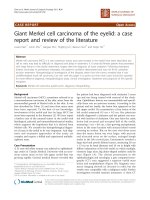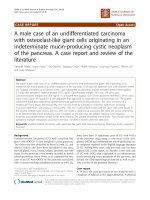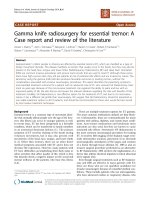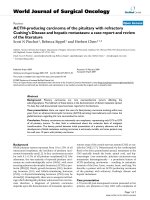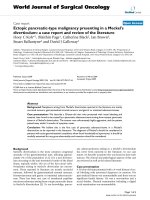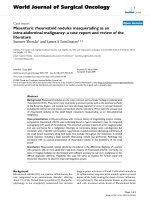Báo cáo khoa hoc:" mosaic with hydrocephaly: a case report and review of the literature" docx
Bạn đang xem bản rút gọn của tài liệu. Xem và tải ngay bản đầy đủ của tài liệu tại đây (229.75 KB, 3 trang )
BioMed Central
Page 1 of 3
(page number not for citation purposes)
Journal of Medical Case Reports
Open Access
Case report
47,XXY/48,XXXY/49,XXXXY mosaic with hydrocephaly: a case
report and review of the literature
Jesús E Dueñas-Arias
†1
, Maribel Aguilar-Medina
†2
, Eliakym Arámbula-
Meraz
2
, Juliana B Valenzuela-Camacho
1
, Angelina Vega-Solano
1
,
Julio Granados
3
and Rosalío Ramos-Payán*
2
Address:
1
Departamento de Genética, Hospital Pediátrico de Sinaloa. Culiacán, Sinaloa, México,
2
Laboratorio de Inmunología y Biología
Molecular, Doctorado en Biotecnología, Facultad de Ciencias Químico Biológicas, Universidad Autónoma de Sinaloa. Culiacán, Sinaloa, México
and
3
Departamento de Inmunología y Reumatología, Instituto Nacional de Ciencias Médicas y Nutrición Salvador Zubirán, México D.F., México
Email: Jesús E Dueñas-Arias - ; Maribel Aguilar-Medina - ; Eliakym Arámbula-
Meraz - ; Juliana B Valenzuela-Camacho - ; Angelina Vega-
Solano - ; Julio Granados - ; Rosalío Ramos-Payán* -
* Corresponding author †Equal contributors
Abstract
Klinefelter's syndrome is a frequent genetic sexual alteration in males, associated with the 47,XXY
aneuploidy. Several syndrome variants are caused by different X and Y polysomy and mosaicisms,
including the 49,XXXXY condition described by some authors as Fraccaro's syndrome. Mosaics
with three or more different chromosomal lines are very rare. Here, we describe a case with XXY/
XXXY/XXXXY mosaic in a newborn with clinical features of Fraccaro's syndrome, but also with
obstructive hydrocephaly which has not been reported previously.
Background
Klinefelter's syndrome is a common sex chromosomal
abnormality observed in humans, with a prevalence of 1
in 500 males [1-3]. The clinical features are variable but
often include infertility, gynecomastia, eunuchoidism,
small testes and penis and hypergonadotropic hypogo-
nadism. The syndrome is usually caused by the presence
of one additional X chromosome (47,XXY aneuploidy),
however, rare syndrome variants with X and Y polysomy,
mosaicisms and aberrant chromosomes have been
reported, including 46,XX, 48,XXXY, 48,XXYY, 49XXXXY,
47,XXY/48,XXXY and 48,XXXY/49,XXXXY among others
[4].
The 49,XXXXY chromosomal constitution was described
by Fraccaro in 1960 [5]. Despite being usually considered
as a Klinefelter variant, the 49,XXXXY aneuploidy shows a
distinct phenotype and more severe clinical features [6,7].
More than one hundred cases have been reported, with a
frequency of 1 in 85,000 males [1,8].
Klinefelter with mosaicisms presents a moderate pheno-
type and accounts for 15% of all cases [6]. The 47,XXY/
48,XXXY/49,XXXXY is a very rare mosaic, and to our
knowledge, only three cases have been reported until now
[9-11]. In this paper, we described XXY/XXXY/XXXXY
mosaicism in a newborn with congenital obstructive
hydrocephalus and mild cardiopathy.
Case presentation
Clinical history. A 5-day old male was admitted at the
Pediatric Hospital of Sinaloa in México. His parents were
Published: 19 September 2007
Journal of Medical Case Reports 2007, 1:94 doi:10.1186/1752-1947-1-94
Received: 29 May 2007
Accepted: 19 September 2007
This article is available from: />© 2007 Dueñas-Arias et al; licensee BioMed Central Ltd.
This is an Open Access article distributed under the terms of the Creative Commons Attribution License ( />),
which permits unrestricted use, distribution, and reproduction in any medium, provided the original work is properly cited.
Journal of Medical Case Reports 2007, 1:94 />Page 2 of 3
(page number not for citation purposes)
unrelated. He was born by cesarean section at week 39 due
to fetal arrhythmias and intrauterine growth retardation.
He had an Apgar score of 8 at 1 minute and 9 at 5 minutes,
2 Kg birth weight, 47 cm body length and 37 cm cephalic
circumference. The patient was hospitalized because clin-
ical examination revealed several congenital abnormali-
ties: hypotrophy, macrocephaly, facial asymmetry,
hypertelorism, low nasal bridge, low-set ears, microg-
nathia, short neck, narrow thorax, bulky abdomen, clin-
odactyly of the fourth and fifth fingers of both hands,
hyperpigmented genitals, micropenis, hypospadia and a
mid-scrotal septum with left cryptorchism.
Laboratory data. Radiographs showed no osseous abnor-
malities in joints and long bones. Echocardiography
revealed a 1.6 mm arterial vessel with bidirectional flux
and atrioventricular concordance. Abdominal ultrasound
was normal, but anomalies were observed in the transfon-
tanelle ultrasonography. Magnetic resonance imaging of
the head confirmed the presence of supratentorial non-
communicating hydrocephaly with slightly hypoplastic
corpus callosum (figure 1).
Genetic analysis. Cytogenetic study by GTG banding of
peripheral lymphocytes showed a XXY/XXXY/XXXXY
mosaicism (data not shown). FISH analysis of 207 cellu-
lar nuclei, using probes for chromosomes X and Y, indi-
cated a line proportion of 3% for 47,XXY, 36% for
48,XXXY and 61% for 49,XXXXY (figure 2).
Discussion
Fraccaro's syndrome is caused by 49,XXXXY chromo-
somal aneuploidy and is a rare condition often classified
as a Klinefelter's syndrome variant, however, as stated by
Peet and Hou, we propose that it should be diagnosed as
an independent clinical syndrome [8,7].
In this paper, we describe a newborn with a XXY/XXXY/
XXXXY mosaicism with Fraccaro's syndrome phenotype.
The percentage of the 49,XXXXY line was 61% as deter-
mined by nuclei FISH analysis (figure 1), which is in
accordance with the clinical features of the patient. To our
knowledge, this is the fourth report of this mosaicism in
the literature, but with different line proportion and clin-
ical phenotypes. Moreover, the child had mild cardiopa-
thy and supratentorial non-communicating
hydrocephalus (figure 2). Whether this congenital hydro-
cephaly is a new syndrome variant or just an independent
event remains to be determined. As the presence of hydro-
cephaly in patients with XXY/XXXY/XXXXY mosaicism
has not been reported before in any Klinefelter variants
nor in Fraccaro's syndrome, it should be considered in
future cases, during cytogenetic analysis and in the first six
months after birth.
Competing interests
The author(s) declare that they have no competing inter-
ests.
Authors' contributions
DAJE provided genetic counselling to the parents. AMM
and DAJE collected the data relative to this case report.
VMJB and VSA conducted the data analysis and inter-
preted experiments and revised the manuscript. AMM,
AME, GJ and RPR performed genetic studies and elabora-
tion and drafting of the manuscript. All authors read and
approved the final manuscript.
Magnetic Resonance of head (MR-Head)Figure 1
Magnetic Resonance of head (MR-Head). MR-Head showing supratentorial non-communicating hydrocephalus (a, b) and
slightly hypoplastic corpus callosum (c).
Publish with BioMed Central and every
scientist can read your work free of charge
"BioMed Central will be the most significant development for
disseminating the results of biomedical research in our lifetime."
Sir Paul Nurse, Cancer Research UK
Your research papers will be:
available free of charge to the entire biomedical community
peer reviewed and published immediately upon acceptance
cited in PubMed and archived on PubMed Central
yours — you keep the copyright
Submit your manuscript here:
/>BioMedcentral
Journal of Medical Case Reports 2007, 1:94 />Page 3 of 3
(page number not for citation purposes)
Consent
Written consent was obtained from the newborn's mother
for publication of this case report.
Acknowledgements
Aguilar-Medina M, Ramos-Payán R, Arámbula-Meraz E are SNI fellows. This
work was supported by the General Coordination of Research and Pos-
graduate (CGIP-PROFAPI) Universidad Autónoma de Sinaloa and CECYT
(State Council of Science and Technology) from Sinaloa, México.
References
1. Visootsak J, Graham JM Jr: Klinefelter syndrome and other sex
chromosomal aneuploidies. Orphanet J Rare Dis 2006, 24:42.
2. Jacobs PA, Strong JA: A case of human intersexuality having
possible XXY sex-determining mechanism. Nature 1959,
2:164-167.
3. Klinefelter HF, Reifenstein EC, Albright F: Syndrome character-
ized by gynecomastia aspermatogenes without A-Leydigism
and increased excretion of follicle stimulating hormone. J Clin
Endocrinol Metab 1942, 2:615-627.
4. Hirschhorn K, Hirschhorn R, Fraccaro M, Book JA: Incidence of
familial hyperlipemia. Science 1959, 129:716-7.
5. Fraccaro M, Kaijser K, Lindsten J: A child with 49 chromosomes.
Lancet 1960, 2:899-902.
6. Wattendorf DJ, Muenke M: Klinefelter syndrome. Am Fam Physi-
cian 2005, 72:2259-62.
7. Peet J, Weaver DD, Vance GH: 49,XXXXY: a distinct pheno-
type. Three new cases and review. J Med Genet 1998, 35:420-4.
8. Hou JW: 49, XXXXY syndrome. Chang Gung Med J 2004,
27:551-4.
9. Tumba A: Case of triple chromosome mosaicism XXY/
XXXY/XXXXY. Union Med Can 1975, 104:739-44.
10. Kardon NB, Beratis NG, Hsu LY, Moloshok RE, Hirschhorn K:
47,XXY-48,XXXY-49,XXXXY mosaicism in a 4-year-old
child. Am J Dis Child 1971, 122:160-2.
11. Guli E, Cellesi C: Klinefelter's syndrome with XXXY-XXY-
XXXXY mosaic. Atti Accad Fisiocrit Siena 1967, 16:1281-91.
Fluorescence In situ Hybridization (FISH) assayFigure 2
Fluorescence In situ Hybridization (FISH) assay. Nuclei FISH analysis of peripheral lymphocytes reveals a XXY/XXXY/
XXXXY mosaic in a, b and c respectively.

